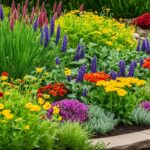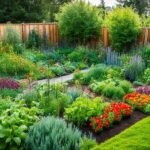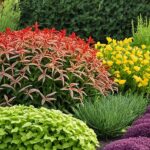Sustainable Gardening
Creating a Balanced Garden Ecosystem with Companion Planting
Ever wondered how ancient gardeners got such great harvests? The secret is in companion planting. This method uses the natural links between plants to make gardens thrive. We’ll dive into the ancient wisdom of companion planting and show how it can make your garden a lush, self-sustaining place.
Key Takeaways
- Discover the ancient roots of companion planting and how it can benefit your modern garden
- Learn how to leverage natural pest control and enhance biodiversity using strategic plant pairings
- Optimize your garden’s space and yield through thoughtful companion planting techniques
- Attract beneficial insects, pollinators, and wildlife to create a thriving garden ecosystem
- Explore proven companion planting combinations for soil health, visual appeal, and long-term success
Imagine a garden that thrives without harmful pesticides or too much work. Companion planting is the answer. By using this method, you can make your garden a lush, thriving space that works with nature. It’s time to bring this ancient wisdom into your modern garden.
The Ancient Wisdom of Companion Planting
Companion planting has been around for a long time, going back to ancient times. It’s based on the “Three Sisters” method from Indigenous American farming. This method uses corn, beans, and squash together.
Tracing the Origins: From Ancient Civilizations to Modern Gardens
For centuries, farmers used companion planting in many cultures. The early cottage gardens were designed to help plants work together. They picked plants that helped each other out, like fighting pests or sharing nutrients.
The Three Sisters: An Indigenous Tradition of Symbiotic Planting
The “Three Sisters” method is a key part of Indigenous American farming, going back over 3,000 years. It’s about growing corn, beans, and squash together. Corn helps the beans grow by providing a structure for them to climb on.
Beans are great at making the soil richer with nitrogen. Squash spreads out and covers the ground, keeping it moist, stopping weeds, and keeping the soil cool.
“The Three Sisters method embodies a harmonious relationship between three staple crops: corn, beans, and squash.”
This old way of planting is still guiding today’s gardeners. They aim to mimic the natural balance found in nature.
Unleashing Nature’s Power: Companion Planting Benefits
Companion planting is a natural way to control pests and boost garden diversity. By pairing certain plants, you can keep pests away and draw in helpful insects. This creates a balanced and thriving garden ecosystem.
Natural Pest Control: Repelling Pests with Strategic Plant Pairings
Some flowers, like nasturtiums and marigolds, have strong smells that pests don’t like. These plants can keep aphids, beetles, and other pests away. Adding them to your garden helps you avoid harsh chemicals and keeps your garden healthy.
Enhancing Biodiversity: Attracting Beneficial Insects and Wildlife
Having different plants in your garden improves soil health and fights pests and diseases. By choosing a variety of flowers, you’ll draw in helpful insects, birds, and wildlife. Flowers like bee balm and echinacea help bees and butterflies, making sure plants can reproduce well. This makes your garden stronger and healthier.
“By incorporating companion plants, you can create a natural pest control system while attracting a diverse array of beneficial insects and wildlife, resulting in a thriving and balanced garden ecosystem.”
Companion planting is a green and complete way to garden. It uses nature to control pests, increase diversity, and improve plant health. With the right plant combinations, your garden can be full of life and self-sustaining.
Optimizing Space and Yield with Companion Planting
Root crops like radishes, carrots, and beets are great for companion planting. They grow well together and can be harvested at different times. This makes them perfect for a busy garden.
By planting these vegetables together, gardeners can use space wisely and get fresh produce all season. It’s a smart way to make the most out of your garden.
Root Crop Companions: Maximizing Space and Harvest Potential
Radishes, carrots, and beets work well together. Radishes grow fast and can be planted between the slower-growing carrots and beets. This way, you use space well and can pick radishes early.
As you pick the radishes, the carrots and beets have room to grow. This method makes your garden more efficient and productive.
But there’s more to companion planting for root crops. Adding plants like dill, lettuce, beans, and cucumbers between them makes your garden better. It uses space well and makes your garden more diverse and productive.
“By embracing the principles of companion planting, gardeners can transform their root crop beds into veritable oases of productivity and efficiency.”
Success comes from knowing how each root crop grows and when it’s ready to be picked. With some planning and creativity, you can use companion planting to make your garden better. You’ll get more from your space and enjoy a bountiful harvest.
Attracting Beneficial Insects: Pollinators and Predators
Creating a great garden is not just about growing plants. It’s also about inviting beneficial insects to your garden. These insects are key to a balanced garden. They help pollinate plants and eat pests.
Cover crops like clover and buckwheat are great for your garden. They offer homes for insects and improve the soil. Clover fixes nitrogen and shelters insects, making the soil richer. Buckwheat grows fast and has many small flowers. These attract beneficial beetles, lacewings, and wasps.
To make your garden a haven for pollinators, plant a variety of flowers. Think about adding lavender, borage, calendula, and sunflowers. These flowers will draw in bees and butterflies, helping your garden grow well.
“Attracting beneficial insects is a key component in creating a balanced garden ecosystem. By providing the right companion plants, you can harness the power of nature to reduce pests and promote healthy plant growth.”
A garden with many different plants is a healthy garden. By choosing plants that attract beneficial insects, you’ll create a lush, productive, and balanced garden.
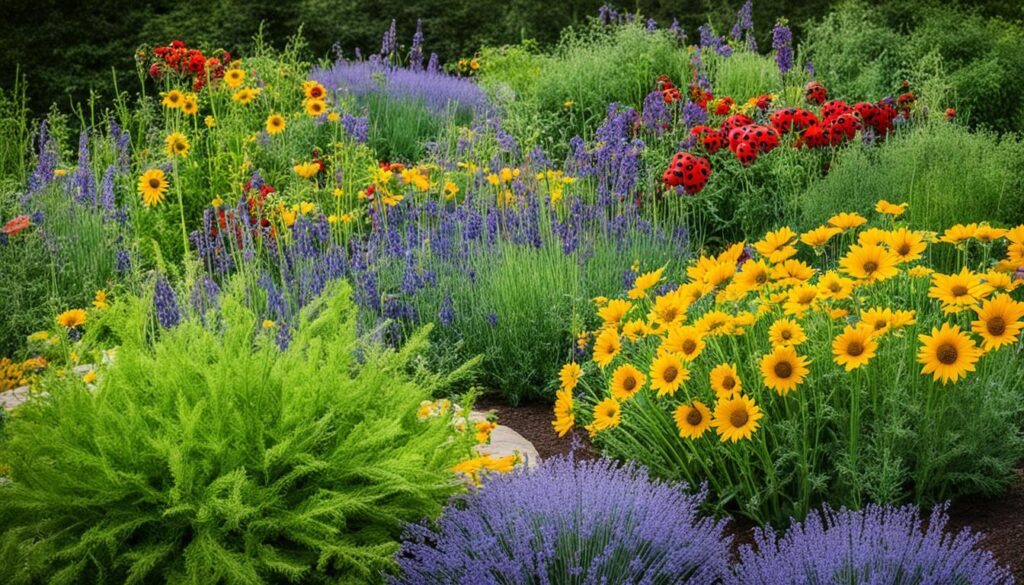
| Companion Plant | Insects Attracted | Benefits |
|---|---|---|
| Clover | Various predatory insects, including beetles and lacewings | Nitrogen fixation, soil enrichment, habitat provision |
| Buckwheat | Parasitic wasps, hover flies, ladybugs | Fast-growing, abundant small flowers, habitat for beneficial insects |
| Lavender, Borage, Calendula, Sunflowers | Bees, butterflies, hummingbirds | Attractive to a wide range of pollinators, ensuring healthy harvests |
Embracing Diversity: Flower Companions for a Vibrant Garden
Creating a beautiful garden starts with picking flowers that look good together. By using flower companion planting, you can make a garden that looks great all season. This approach makes your garden diverse and thriving.
Complementary Colors and Bloom Times for Visual Appeal
Choosing the right colors for your flowers is key to a stunning garden. Pairs like blue and orange or purple and yellow make your garden pop. Mixing different shades within these pairs adds depth and interest.
It’s also important to plan when your flowers will bloom. Mixing early, mid, and late bloomers ensures your garden stays colorful all season. This approach also feeds pollinators and keeps your garden beautiful over time.
Annual and Perennial Flower Pairings for Continuous Beauty
Knowing the difference between annual and perennial flowers helps plan a beautiful, easy garden. Annuals bloom for one season and need replanting each year. Perennials come back every year, spreading and becoming a garden staple.
Using both annual and perennial flower companions means your garden looks great with less work. This mix offers continuous color and texture. It attracts pollinators and delights everyone who sees it.
“The true essence of a garden lies in its ability to captivate the senses and nourish the soul. By embracing the diversity of flower companions, we can cultivate a sanctuary that reflects the ever-changing beauty of nature.”
balanced garden ecosystem companion planting
Companion planting is a great way to make your garden better. Some plants help improve the soil, making it healthier for all plants around them. For example, marigolds can keep pests away and make the soil healthier Borage adds important minerals to the soil and has deep roots that help the soil structure. Comfrey pulls nutrients from deep in the soil and releases them as it breaks down, making the soil richer. Adding these plants helps create a garden that’s full of life and healthy soil.
Encouraging Biodiversity: Creating a Haven for Wildlife
Having many different plants in your garden makes the soil healthier and keeps pests away. By planting flowers that attract insects, birds, and other wildlife, you make your garden a better place for them. Flowers like bee balm and echinacea help bees and butterflies, which is good for your plants and your garden. This variety makes your garden stronger and more able to fight off diseases and pests on its own. Adding things like bee hotels and water sources keeps the good bugs in your garden.
| Companion Plants for Soil Health | Benefits |
|---|---|
| Marigolds | Suppress nematodes, improve soil health |
| Borage | Add trace minerals, improve soil structure |
| Comfrey | Draw nutrients from deep in the soil, enrich upper soil layers |
“By incorporating a diverse mix of plants, gardeners can create a thriving, balanced garden ecosystem that supports a wide range of beneficial species.”
Companion Planting Combinations for Success
In sustainable gardening, pairing plants wisely can bring many benefits. By matching nitrogen-fixing plant companions with heavy feeders, and pest-repellent companion plants with pest-attracting trap crops, you can make your garden thrive naturally.
Nitrogen-Fixing Plants and Heavy Feeders
Legumes like peas, beans, or clover fix nitrogen in the soil. They grow well with heavy feeders like corn, tomatoes, or cabbage. These legumes add nitrogen, helping nearby plants grow strong. This nutrient-sharing plant pairing keeps soil fertile and cuts down on synthetic fertilizers.
Pest-Repellent and Pest-Attracting Plant Pairs
Plants with strong smells, like marigolds, garlic, or onions, keep pests away. They act as pest-repellent companion plants. Near carrots or potatoes, they protect against aphids or nematodes. Also, plants like dill or fennel draw pests away from other plants, acting as pest-attracting trap crops.
This mix of pest-repellent and pest-attracting plants helps keep your garden balanced. It uses natural pest management to keep pests away.
Using these companion planting methods, you can make your garden strong and self-sustaining. It will need little care and support the health and productivity of your plants for a long time.
Planning and Implementing Companion Planting
Learning about companion planting takes some planning. Use companion planting resources and gardening guides to make your garden thrive. These guides, like The Old Farmer’s Almanac Companion Planting Guide and Rodale’s Basic Organic Gardening, share tips on pairing plants for the best results.
Don’t just stop there. Contact your local cooperative extension services for advice from gardening pros. They know which plants work well together in your area. They can help with companion plant placement and garden layout design to make your garden better.
Designing Your Garden Layout for Optimal Plant Interactions
Arranging your garden right is key to a great companion planting setup. Think about how tall the plants are, what light they need, and what soil they like. Putting plants together that work well can make better growing conditions for everyone. Use a mix of plants, from low-growing ones to tall ones, to make your garden look good and work well.
“Companion planting is not just about growing plants side by side; it’s about creating a harmonious, symbiotic relationship that benefits the entire garden ecosystem.”
Use companion planting resources and plan your garden well. This way, you can make the most of companion planting. You’ll have a garden that’s full of life, productive, and good for the planet.
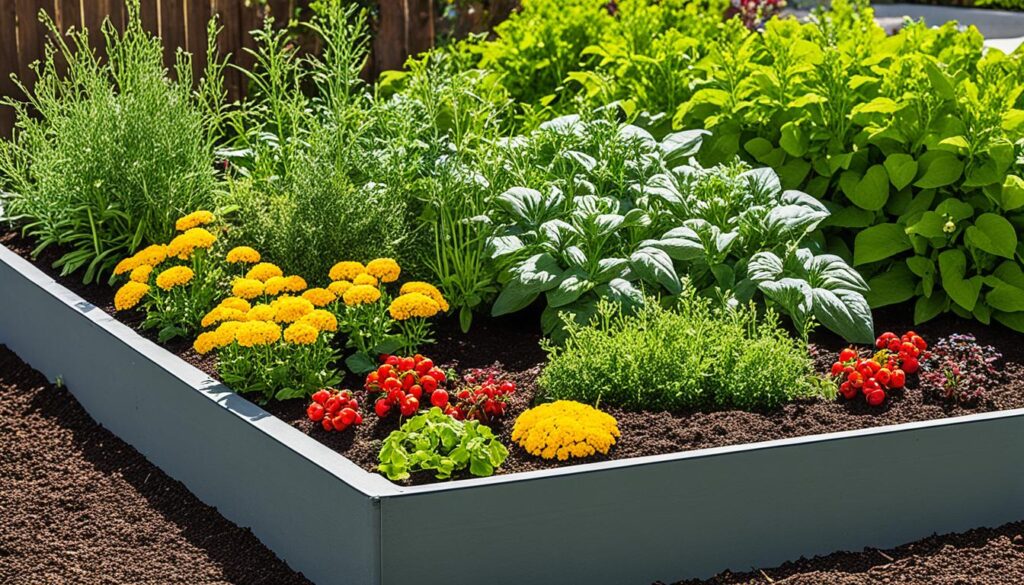
Nurturing a Thriving Garden Ecosystem
To make your garden vibrant and sustainable, watch and adapt. Keep an eye on how plants interact and your garden’s health. This helps you choose the best companion planting strategies. Regular checks let you spot and fix any issues, like adding pest-repellent plants or moving plants around.
Maintaining Balanced Plant Communities Through Observation
Watching how plants interact in your garden is key for its health. Notice how they grow, who eats them, and how strong they are. This helps you adjust your companion planting to make sure each plant does well. It keeps your ecosystem balanced.
Embracing Sustainable Gardening Practices for Long-Term Success
Using sustainable gardening methods helps your garden last longer and be stronger. Add organic stuff to your soil to help it and the plants. Don’t use harmful pesticides and fertilizers. Go for natural ways like planting friends together and using cover crops instead. These eco-friendly choices make your garden self-sustaining and healthy for years.
| Sustainable Gardening Practices | Benefits |
|---|---|
| Incorporating organic matter | Supports soil health and biodiversity |
| Avoiding synthetic pesticides and fertilizers | Promotes a balanced, self-sustaining ecosystem |
| Implementing cover cropping | Enhances soil fertility and nutrient cycling |
Understanding your garden’s ecosystem and using sustainable gardening practices leads to a thriving garden. It will keep doing well for many years.
Conclusion
Companion planting is a great way to make your garden healthier and more productive. It helps control pests, improves soil, and adds beauty to your garden. By using companion planting, you can make your garden a thriving place.
Try new things, watch how they do, and change your plans as needed. This way, you can make the most out of your garden. Companion planting brings together different plants to create a balanced garden.
This approach helps your garden grow well and supports many kinds of life. It’s a way to make your garden better for you and the environment. Start companion planting and see how your garden changes into a beautiful, self-sustaining place.
FAQ
What is the history of companion planting?
Companion planting has a long history, dating back to ancient times. The Mayans, Egyptians, and Indigenous peoples used it to boost crop yields and keep soil healthy.
What is the “Three Sisters” companion planting method?
The “Three Sisters” method comes from Native American tribes. It involves growing corn, beans, and squash together. Corn supports the beans, beans fix nitrogen, and squash keeps the soil moist and weeds down.
How does companion planting help with natural pest control?
Flowers like nasturtiums and marigolds keep pests away with their strong smells and bright colors. They help protect other plants from aphids, beetles, and other pests.
How can companion planting improve soil health and biodiversity?
Plant diversity in the garden makes soil healthier and cuts down on pests and diseases. By using a mix of plants, you attract beneficial insects and wildlife. Flowers like bee balm help bees and butterflies, which is good for plant growth and harvest.
How can companion planting help with space and yield optimization?
Plants like radishes, carrots, and beets grow well together and at different times. By planting them together, you use space better and get fresh produce all season.
How can companion planting enhance the visual appeal of a garden?
Picking flowers with matching colors makes the garden look better. Colors like blue and orange or purple and yellow stand out together. Mixing different shades adds depth and beauty to the garden.
How can companion planting improve soil quality?
Some plants make the soil better for all plants around them. Marigolds fight nematodes and improve soil health. Borage adds minerals and helps soil structure with its deep roots.
What are some effective companion planting combinations?
Legumes like peas and beans work well with heavy feeders like corn and tomatoes. They keep the soil fertile. Planting marigolds, garlic, or onions near other plants keeps pests away with their smell.
Where can I find reliable resources for companion planting guidance?
The Old Farmer’s Almanac Companion Planting Guide and Rodale’s Basic Organic Gardening book are great resources. Local extension services and gardening groups also offer advice on what plants go well together.
How can I maintain a thriving companion planting system?
Keeping a garden healthy means watching the plants and insects closely. Making changes as needed helps keep the garden balanced and productive.
Source Links
Understanding Soil Health: The Foundation of Sustainable Gardening
Do you know the secret to vibrant, thriving plants? It’s right beneath your feet – in the soil! Soil health is key to sustainable gardening, but many gardeners forget this important part. Imagine a garden full of life where plants grow well without harsh chemicals. This is possible with healthy soil.
Your soil is alive, full of tiny creatures and insects that help plants grow. By taking care of this underground world, you can make a garden that’s beautiful, kind to the planet, and sustainable.
Key Takeaways
- Soil health is the foundation for sustainable gardening, supporting plant growth and ecosystem balance.
- A diverse soil biome, including beneficial microbes and organisms, contributes to nutrient cycling, organic matter decomposition, and carbon sequestration.
- Proper soil structure and moisture retention are crucial for healthy plant roots and resilience against environmental stresses.
- Sustainable soil management practices, such as composting and cover cropping, can improve soil fertility and reduce the need for chemical inputs.
- Soil testing and targeted amendments can help address specific nutrient deficiencies and balance the soil’s pH for optimal plant performance.
The Living Soil: A Microbial Wonderland
Underneath your feet, the soil is full of soil microbes like beneficial bacteria, fungi, protozoa, and nematodes. These tiny creatures are key to a healthy garden. They help break down organic matter, release nutrients, and keep plants safe from diseases.
Beneficial Bacteria and Fungi
Beneficial soil bacteria work hard to turn complex organic materials into nutrients for your plants. Soil fungi create networks that carry nutrients to your plants’ roots. These tiny helpers make sure your garden gets the nutrients it needs to grow strong.
Protozoa and Nematodes
Soil protozoa and soil nematodes are also crucial. They eat harmful bacteria and fungi, keeping the soil balanced. This balance is key to your plants getting the right nutrients and staying healthy.
By taking care of the beneficial soil bacteria, soil fungi, soil protozoa, and soil nematodes, you help your garden grow. You’ll get more healthy plants and a garden that takes care of itself.
“The soil is the great connector of lives, the source and destination of all.” – Wendell Berry
Nutrient-Rich Soil: The Key to Healthy Plants
Sustainable gardening means feeding your plants naturally, not with synthetic fertilizers. The key is to create soil rich in nutrients for strong plant growth. Soil’s living things break down things like compost and plant leftovers, giving your plants the nutrients they need.
Natural Nutrient Cycling
This process of nutrient cycling gives your plants what they need and keeps nutrients balanced. It’s better than synthetic fertilizers, which can cause problems. This way, your garden grows healthy and eco-friendly.
Balanced and Sustainable Nutrient Supply
By building soil nutrients, using organic matter, and encouraging nutrient cycling, you make a sustainable soil system. This supports plant nutrition and makes your garden lush and healthy. It also helps your garden stay strong over time.
“The key to a successful, sustainable garden lies in the health of your soil. By nurturing the natural nutrient cycles, you’ll unlock the true potential of your plants.”
Soil Structure and Water Retention
In sustainable gardening, the way your soil is structured is key. It affects aeration, drainage, and how well it holds water. These are crucial for your plants’ health and strength.
Adding organic matter like compost or manure helps improve soil structure. These materials help create a crumbly, porous soil. This makes air and water move better through the soil, helping roots grow and plants use water well.
Organic soils are great at keeping water in, which is vital in dry areas or where rain is unpredictable. They make plants more drought resilient. This means they can survive with less water and do well in tough conditions.
| Soil Property | Importance | Benefit |
|---|---|---|
| Soil Structure | Influences aeration, drainage, and water retention | Promotes plant health and resilience |
| Organic Matter | Improves soil aggregation and porosity | Enhances water movement and drought tolerance |
| Soil Porosity | Allows for better air and water circulation | Supports root growth and plant health |
By focusing on your soil’s structure and how it holds water, you can make your garden thrive. This approach helps your garden deal with climate changes and unpredictable weather. Taking care of your soil is key to a successful and lasting garden.
Biodiversity and soil health
In organic gardening, having a variety of life forms is key. This includes everything from tiny microbes under the soil to different plants above. A balanced ecosystem is vital for keeping your garden healthy.
Mycorrhizal Associations
The heart of this balance is the partnership between plant roots and mycorrhizal fungi. These fungi help plants reach more nutrients in the soil. In return, plants give them sugars from photosynthesis. This relationship makes plants healthier and more resistant to problems.
Companion Planting and Ecosystem Balance
Having different plants in your garden is also important for balance. By using various crops and cover plants, you can fight pests and diseases naturally. This way, you use helpful insects and microbes to keep your garden healthy without chemicals.
By focusing on soil biodiversity, you can create a garden that’s full of life. It will give you lots of food and help the environment. Discover how the living soil works, and see your garden grow with nature’s help.
Pest and Disease Management Naturally
Organic gardening focuses on preventing pests and diseases with natural methods. It starts with healthy soil, which helps plants stay strong. Healthy soil has many microorganisms that fight diseases and make plants stronger against pests.
Disease Suppression through Diverse Microbes
Beneficial microbes in the soil work together to stop plant diseases. They compete with harmful organisms for resources and produce antibiotics. By using organic gardening, you can use nature’s own ways to fight diseases.
Resilient Plants through Proper Nutrition
Plants that get the right nutrients are stronger against pests and diseases. They grow stronger cell walls and have better immune systems. They also make more compounds that keep pests away. Using companion planting helps plants work together to stay healthy.
| Organic Gardening Practice | Benefit for Pest and Disease Management |
|---|---|
| Diverse Soil Microbiome | Suppresses plant diseases through competition, antibiotic production, and direct parasitism of pathogens |
| Balanced Nutrient Supply | Strengthens plant immunity and production of natural pest-deterring compounds |
| Companion Planting | Enhances plant resilience through mutually beneficial relationships between different crops |
Organic gardeners use natural methods to manage pests and diseases. They focus on the soil’s living diversity and give plants the right nutrients. This approach creates a healthy, sustainable garden.
The Role of Organic Matter
Organic matter is key to a healthy garden. Adding different organic materials to your soil brings many benefits. These help plants grow better and make your garden more sustainable.
Composting and Cover Crops
Composting changes kitchen scraps and yard waste into a soil booster. It helps reduce waste and gives your garden a valuable resource. Cover crops like legumes and clover help during off-growth seasons. They stop soil erosion, fight weeds, and add organic matter when plowed under.
Mulching for Moisture Retention
Using mulch, such as straw or wood chips, on your garden beds is very helpful. It keeps the soil moist, stops weeds, and keeps the soil temperature right. This is great for the tiny helpers that make plants grow and cycle nutrients.
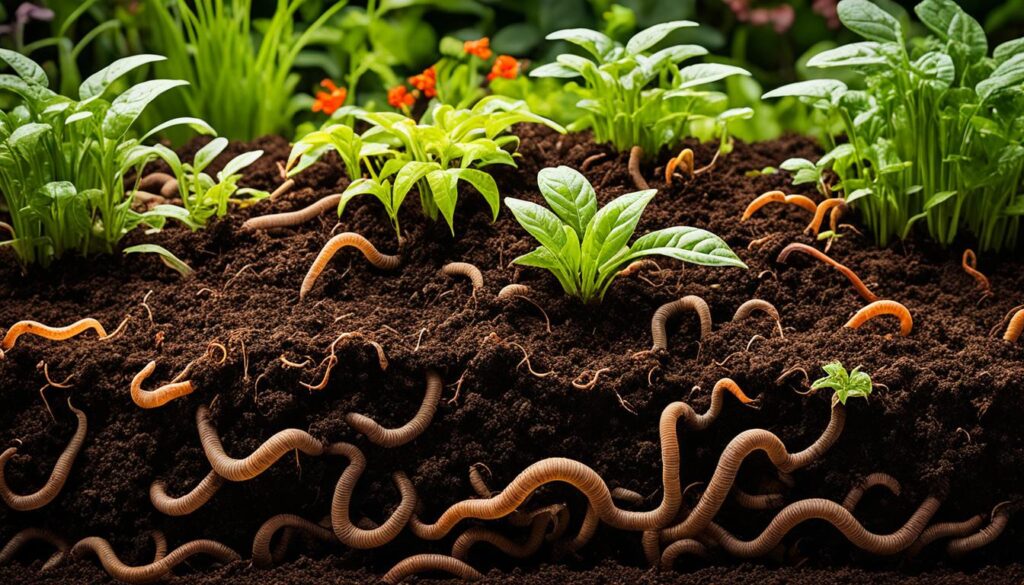
“The health of soil, plant, animal and man is one and indivisible.” – Lady Eve Balfour
Using organic matter makes your garden strong and healthy. Practices like composting, cover cropping, and mulching work together. They build a strong soil base for sustainable gardening for many years.
Soil Testing and Amendments
Healthy soil is key to sustainable gardening. Soil testing helps you understand your soil’s makeup. This lets you choose the right soil amendments to boost fertility and pH levels. This supports the growth of healthy, strong plants.
Home soil testing kits give you insights into nutrient levels, organic matter, and pH balance. With this info, you can fix any issues. This ensures your plants get the nutrients they need to grow well.
Adjusting Soil pH
Soil pH affects nutrient availability. If your soil is too acidic or alkaline, you might need to adjust it. Using lime or sulfur can help. These amendments change the pH to create a better environment for plants.
Balancing Nutrient Levels
Soil tests show nutrient levels like nitrogen, phosphorus, and potassium. Knowing these levels lets you add amendments like compost or manure. This ensures your plants get the nutrients they need.
Adding organic matter, like compost or cover crops, improves soil structure and health. This supports sustainable gardening in the long run.
| Soil Amendment | Purpose | Recommended Application Rate |
|---|---|---|
| Limestone | Increase soil pH | 2-4 lbs per 100 sq ft |
| Sulfur | Decrease soil pH | 1-2 lbs per 100 sq ft |
| Compost | Improve soil structure and nutrient levels | 2-4 inches worked into the top 6-8 inches of soil |
| Balanced Organic Fertilizer | Provide a comprehensive nutrient boost | Follow product instructions for application rates |
Regular soil testing and targeted amendments create a nutrient-rich environment. This supports your plants’ health and vitality. It ensures a bountiful harvest year after year.
“The key to a successful garden is in the soil. By understanding and nurturing the foundation of your growing space, you unlock the true potential of your plants.”
Carbon Sequestration and Climate Change Mitigation
As an organic gardener, you have a big role in fighting climate change. The health of your soil is key in carbon sequestration and climate change mitigation.
Organic gardening helps pull carbon dioxide from the air and store it in the soil. The organic matter you add acts as a carbon sink. This is crucial for fighting climate change.
- Organic gardening builds up organic matter in the soil, which stores carbon.
- Healthy soils can hold a lot of atmospheric carbon, lowering greenhouse gas levels.
- By using sustainable gardening methods, you help fight climate change and show environmental responsibility.
| Sustainable Gardening Practice | Carbon Sequestration Benefits |
|---|---|
| Composting | Adds organic matter to the soil, increasing its carbon-holding capacity. |
| Cover Cropping | Promotes the growth of plant roots, which help store carbon in the soil. |
| Mulching | Retains soil moisture and prevents the release of stored carbon into the atmosphere. |
Organic gardening helps make our planet sustainable and fights climate change. Your garden can be a carbon sink, tackling global environmental issues.
“Soil is the foundation of life, and it is our responsibility to protect and nurture it. Through organic gardening, we can create a healthier, more resilient planet for future generations.”
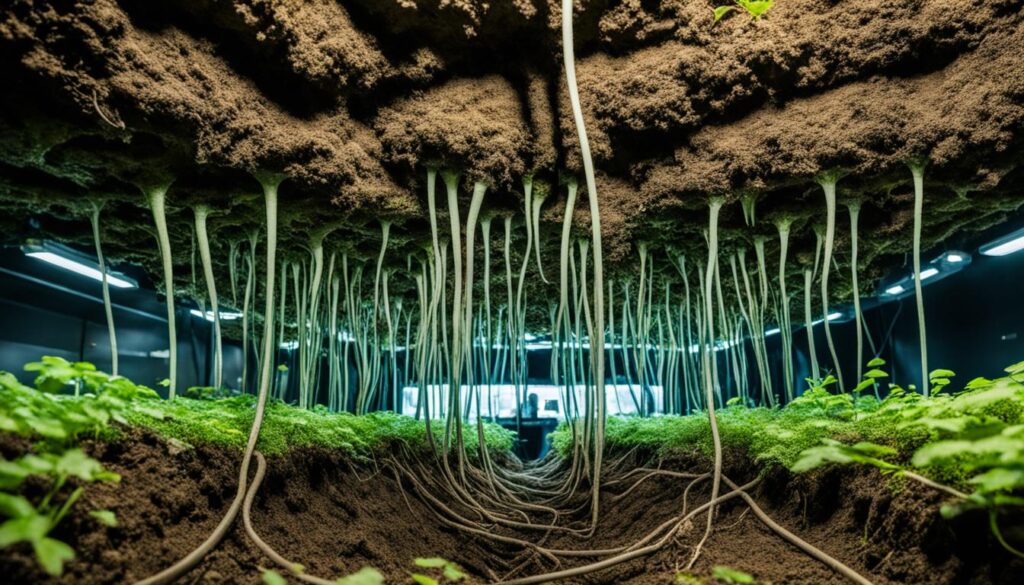
Soil Health: The Foundation of Sustainable Gardening
Soil health is key to sustainable gardening. It’s vital for growing plants that are healthy and in harmony with nature. By focusing on soil health, gardeners can grow more food and protect the environment.
Organic gardening means working with nature, not against it. It avoids synthetic fertilizers and pesticides. Instead, it builds a living ecosystem in the soil. This way, plants get the nutrients they need and supports many living things, making gardens healthy and full of life.
Understanding the life under our feet is crucial for organic gardening. Soil is full of tiny helpers like bacteria and fungi that are key for plant health. By taking care of these tiny helpers, gardeners can make their gardens strong and self-sufficient.
“Soil health is the foundation of sustainable gardening. By focusing on building and maintaining nutrient-rich, biologically diverse, and structurally sound soil, organic gardeners can create thriving gardens that are resilient, sustainable, and in tune with the natural world.”
Practices like cover cropping and composting help improve soil. They make it better at holding water and giving plants what they need. These methods help plants grow strong and support the environment by fighting climate change.
Soil health is the core of sustainable gardening. By taking care of the soil, gardeners grow healthy plants and protect nature. This way, they can enjoy a garden that’s full of life and good for the planet.
Conclusion
Your journey to sustainable gardening starts with soil health. By understanding life beneath the surface, you can make your garden thrive. It will give you lots of harvests and help the environment.
Using organic gardening methods like compost and natural pest control helps. These practices feed soil microbes and improve nutrient cycling.
As a gardener, you play a big role in fighting climate change by storing carbon in the soil. Your focus on soil health helps your plants and protects our ecosystem. By following organic gardening, you become a guardian of the earth, keeping your garden and the planet healthy for the future.
Soil health is key to your sustainable gardening journey. By making your soil rich and diverse, you unlock your garden’s full potential. You’ll get healthy plants and lots of food while helping the environment.
FAQ
What is the importance of soil health in gardening?
Soil is key to life on Earth, linking plants, the atmosphere, and our health. It’s vital for sustainable gardening and plant growth. Healthy, nutrient-rich soil is essential.
How do soil microorganisms contribute to soil health?
Soil is full of tiny living things like bacteria and fungi. These microbes help break down organic matter and make nutrients for plants. They also protect plants from diseases.
How does organic gardening nourish plants naturally?
Organic gardening aims to feed plants without synthetic fertilizers. It focuses on building nutrient-rich soil. This lets soil organisms break down organic matter and release nutrients for plants.
Why is soil structure important in organic gardening?
Soil structure is crucial in organic gardening. It affects aeration, drainage, and water retention, which are key for plant health. Adding organic matter like compost improves soil structure, helping roots grow and air and water move through the soil.
How does organic gardening encourage biodiversity?
Organic gardens support life above and below ground. Soil microbes help plants by making nutrients available and fighting diseases. Planting a variety of crops helps pests and diseases by supporting beneficial insects and organisms.
How can organic gardening practices help manage pests and diseases naturally?
Organic gardening uses natural ways to fight pests and diseases. Healthy soil and diverse microorganisms help prevent many garden problems. Planting certain crops together can also keep pests away and attract good insects.
Why is the incorporation of organic matter essential in organic gardening?
Adding organic matter is key in organic gardening. Practices like composting and mulching enrich soil and help microorganisms. This creates a good environment for plants to grow.
How can soil testing benefit organic gardeners?
Soil testing helps organic gardeners know what their soil needs. It shows the pH, nutrient levels, and organic matter content. This info helps gardeners choose the right amendments for their soil.
How does organic gardening contribute to climate change mitigation?
Organic gardening helps fight climate change by storing carbon in soil. Organic matter acts as a carbon sink, pulling CO2 from the air. By gardening organically, people can help reduce carbon emissions and support sustainability.
Source Links
- https://mountviewservices.com/understanding-soil-health-a-key-to-sustainable-landscaping/ – Understanding Soil Health – A Key to Sustainable Landscaping
- https://alluvialsoillab.com/blogs/news/the-crucial-role-of-soil-in-organic-gardening-nurturing-a-sustainable-harvest-enhancing-soil-health-through-testing – The Crucial Role of Soil in Organic Gardening: Nurturing a Sustainable Harvest, Enhancing Soil Health Through Testing | Alluvial Soil Lab
- https://extension.oregonstate.edu/catalog/pub/em-9409-understanding-soil-health-biota-farms-gardens – Understanding Soil Health and Biota for Farm and Garden
How to Start a Sustainable Garden: A Beginner’s Guide
Do you want to make your gardening greener? Starting a sustainable garden can seem hard, but it’s a journey that’s good for you and the planet. Learn how to turn your yard into a lush, self-sustaining garden that matches your values and gives you lots of fresh produce.
Key Takeaways
- Understand the principles of sustainable gardening and its benefits for the environment.
- Identify the right location for your garden based on sunlight and shade considerations.
- Learn how to prepare the soil and create raised garden beds to enhance fertility.
- Discover the best plants to grow in a sustainable garden, including perennials and fruit trees.
- Implement water conservation strategies like rainwater harvesting and mulching.
Starting a sustainable garden is more than just growing food. It’s about making a space that helps nature’s balance. By using eco-friendly methods, you can lower your environmental impact, save resources, and enjoy a garden that keeps giving. Are you ready to learn how to create a sustainable garden that will thrive for years?
Understanding Sustainable Gardening
Sustainable gardening is all about making a garden that’s good for the planet. It helps reduce your carbon footprint, builds healthy soil, and brings in good bugs. Plus, you get to enjoy fresh, healthy food all year round.
What is a Sustainable Garden?
A sustainable garden uses organic ways to grow and saves resources. It works like nature to make the most of things like compost and mulch. This way, you get lots of good stuff and use less of everything else.
Benefits of Sustainable Gardening
Switching to a sustainable garden has lots of perks, like:
- Less carbon footprint from not using synthetic stuff
- Better soil health with organic stuff and natural helpers
- More bugs that help your garden grow
- Always having fresh, healthy food at home
- Saving money compared to regular gardening
Choosing eco-friendly gardening means you get lots of benefits. You help make the planet healthier and more resilient.
“Sustainable gardening is not just a trend – it’s a way of life that benefits both you and the environment.”
Choosing the Right Location
Choosing the right spot for a sustainable garden is crucial. It’s all about finding a place that fits the sunlight and shade needs of your plants. This is key to a successful garden.
Sunlight and Shade Considerations
Most veggies need at least 6 hours of sunlight every day. But, some like leafy greens can do well in partial shade. Make sure your garden spot has good drainage and isn’t near trees with deep roots. Also, being close to water and your kitchen is handy.
- Look for a location that receives at least 6 hours of direct sunlight per day.
- Ensure the area has good drainage and is not dominated by heavy tree roots.
- Choose a spot that is close to a water source and your kitchen for easy access.
- Research the specific sunlight requirements for the vegetables and plants you wish to grow.
By picking a spot that meets the garden location tips and choosing a garden site with enough sunlight for vegetables, you’re setting up for a successful garden. This will give you a rich harvest for many years.
Preparing the Soil
Healthy, nutrient-rich soil is key for a thriving garden. Proper soil prep helps plants grow well and cuts down on chemical use. Here are some steps to get your soil ready for plants.
Creating Raised Garden Beds
Building raised garden beds is a great idea. These beds let you control the soil and drainage. Just frame an area with wood or stone and fill it with good potting mix or soil with compost.
This design helps with air flow and warms the soil early, giving plants a great start.
Enhancing Soil with Compost and Mulch
Adding organic matter is crucial, whether you till or use raised beds. Compost boosts soil structure, nutrients, and water retention. Spread 2-4 inches of compost and mix it well into the soil.
Using a thick layer of organic mulch also helps. It keeps soil moist, controls weeds, and enriches the soil as it breaks down.
| Soil Preparation Technique | Benefits |
|---|---|
| Raised Garden Beds |
|
| Compost Addition |
|
| Organic Mulch |
|
Using these soil prep methods in your garden plan helps plants thrive.
Selecting Plants for a Sustainable Garden
Choosing the right plants is key to a sustainable garden. Go for native and adapted plants that love your local climate. These plants need less water and food, making them great for the planet.
Adding a mix of vegetables, herbs, and flowers will draw in pollinators and beneficial insects. This helps create a healthy garden. Plus, you’ll get lots of fresh produce and beautiful flowers.
| Plant Type | Benefits for Sustainable Gardening |
|---|---|
| Native Plants | Adapted to local climate conditions, requiring less water and maintenance |
| Disease-Resistant Hybrids | Reduce the need for pesticides and fungicides, promoting a healthier garden |
| Pollinator-Friendly Flowers | Attract bees, butterflies, and other beneficial insects to support a thriving ecosystem |
By picking plants that fit your sustainable gardening goals, you can make a beautiful, easy-care garden. It will look great and help the environment in your area.
“The true essence of a sustainable garden lies in the plants you choose to cultivate. By embracing native and adapted varieties, you can create a resilient, low-impact landscape that thrives with minimal intervention.”
Incorporating Perennials and Trees
Creating a sustainable garden is easier with perennial plants and fruit trees or bushes. These plants bring many benefits that make your garden better over time.
Advantages of Perennial Plants
Perennials like perennial flowers, herbs, and grasses are great for your garden. They come back every year, needing less care and water. They also help improve soil health as they grow.
- Reduced maintenance and watering needs
- Improved soil structure and fertility
- Consistent, long-lasting plant coverage
- Diverse habitats for beneficial insects and pollinators
Fruit Trees and Bushes
Adding fruit trees and berry bushes to your garden is smart. They give you lots of tasty food and help the environment. These plants store carbon, protect wildlife, and make your garden’s climate better.
| Fruit Tree | Fruit Bushes |
|---|---|
| Apple | Blueberry |
| Pear | Raspberry |
| Peach | Blackberry |
| Cherry | Currant |
Using perennial plants for sustainable gardens and growing fruit trees and bushes is smart. You get the amazing benefits of perennials. Your garden will be a beautiful, self-sustaining place for years.
Water Conservation Strategies
Water conservation is key in sustainable gardening. By using water-saving techniques, gardeners can lessen their environmental impact. They also ensure their gardens stay healthy and resilient over time.
Rainwater Harvesting
Rainwater harvesting is a great way to save water. Gardeners can collect rain in barrels or cisterns. This reduces their need for municipal water and uses rainwater for plants.
This method not only saves water but also helps refill groundwater and ease the load on water systems.
Mulching and Ground Cover
Mulching and ground cover are also vital for saving water. Organic mulch, like wood chips or leaves, keeps soil moist, cutting down on watering needs. Ground covers, such as low-growing plants or clover, stop evaporation and keep soil cool. This saves even more water.
By using these strategies, your garden will use less water and stay healthy. Rainwater harvesting, mulching, and ground cover are easy ways to save water. They help make your garden more eco-friendly.
| Water-Saving Technique | Benefits |
|---|---|
| Rainwater Harvesting |
|
| Mulching and Ground Cover |
|
“Sustainable gardening is not just about growing beautiful plants; it’s about preserving the balance of our ecosystem and safeguarding our precious natural resources.” – Jane Doe, Sustainable Gardening Expert
Attracting Pollinators and Beneficial Insects
Creating a sustainable garden is more than just growing plants. It’s about building a home for a variety of beneficial insects. Attracting bees, butterflies, and hummingbirds, as well as insects that eat garden pests, is key. This keeps your garden healthy and productive over time.
Planting different flowers that bloom at various times is a great way to draw in pollinators. This gives them food all season long. Sunflowers, lavender, zinnias, and coneflowers are great choices for your garden.
Your garden can also be a home for insects that eat pests. Ladybugs, lacewings, and praying mantises are some examples. They help control aphids and caterpillars without the need for chemicals.
To support pollinators and beneficial insects, try these tips:
- Plant a mix of native and non-native flowers that bloom at different times.
- Provide places for insects to live and survive the winter, like log piles or brush piles.
- Avoid using broad-spectrum pesticides, which can harm good insects too.
- Add cover crops and groundcover to help the soil and its ecosystem.
By welcoming pollinators and beneficial insects, you’re making your garden sustainable and balanced. It will flourish year after year.
| Pollinator-Friendly Plants | Beneficial Insects |
|---|---|
| Sunflowers, Lavender, Zinnias, Coneflowers | Ladybugs, Lacewings, Praying Mantises |
“A garden is only as rich and beautiful as the integral health of the system; pollinators are essential to the system’s health.” – Émilie Wapnick
Companion Planting
Starting your sustainable gardening journey? Consider companion planting. This method means growing certain plants close together to help and protect each other. It makes your garden a thriving, self-sustaining place.
Companion planting uses symbiotic plant relationships found in nature. Some plants give out nutrients that help their neighbors. Others keep pests away from your garden. By picking the right plants to grow together, you make your garden more productive and resilient.
Plants that Work Well Together
- Tomatoes and basil: Basil keeps aphids and other pests away from tomatoes.
- Marigolds and vegetables: Marigolds’ strong smell keeps pests away, making them great for your veggies.
- Radishes and carrots: Radishes loosen the soil and bring up nutrients for carrots.
- Beans and corn: Beans fix nitrogen in the soil, which helps corn plants grow.
Using companion planting makes your garden healthy and strong. It needs fewer chemicals and helps your plants grow better. Try different plant combinations and see how your garden thrives with these natural partnerships.
“Companion planting is not just about growing plants together; it’s about creating a harmonious and balanced ecosystem in your garden.”
Sustainable Garden Maintenance
Keeping a sustainable garden is an ongoing task that needs careful planning. Two important methods to help your garden stay healthy are succession planting and crop rotation.
Succession Planting Techniques
Succession planting means planting seeds or seedlings at different times during the growing season. This way, you get a steady flow of fresh produce. By planting at different times, you can have a long harvest, not just a short one.
- Plant early, mid, and late-season varieties of the same crop for a prolonged harvest.
- Replace spent plants with new seedlings to fill gaps and keep your garden productive.
- Try fast-growing, short-season crops to fill in between longer-maturing plants.
The Benefits of Crop Rotation
Crop rotation means growing different plants in the same spot over time. This method has many benefits, including:
- Improved soil fertility: Different crops need different nutrients, so rotating them helps the soil stay rich.
- Reduced pest and disease pressure: Changing what you grow makes it harder for pests and diseases to spread.
- Enhanced biodiversity: A mix of crops supports more beneficial insects and microorganisms, creating a healthy garden ecosystem.
Using these sustainable garden practices keeps your garden productive, strong, and good for the environment for many years.
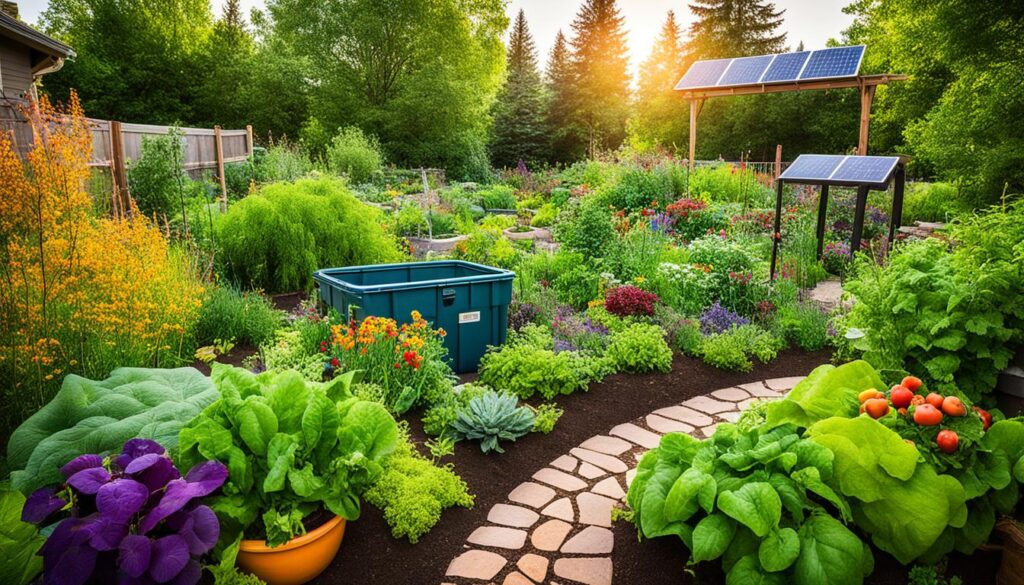
Vertical Gardening
Vertical gardening is a smart way to make your garden both sustainable and productive. It lets you use your space better by growing plants up instead of out. With things like trellises and cages, you can have a garden that takes up less room but is full of life.
One big plus of vertical gardening techniques is how they save space. You can grow plants like tomatoes and peas up the wall instead of on the ground. This makes your garden more productive and looks great too.
Also, growing climbing plants up high has other perks. It helps with air flow, keeps diseases away, and makes picking easier. Plants up high are less likely to get sick and are easier to take care of.
- Use strong supports like trellises or cages for your climbing plants.
- Pick plants that do well up high, like tomatoes, peas, and cucumbers.
- Keep your plants tidy by pruning and training them to grow up the supports.
- Add plants around the base for a pretty and useful garden.
With vertical gardening techniques, you can do amazing things with your garden. Use every inch of space, increase your harvest, and make a garden that shows off your love for the planet and smart gardening.
Saving Seeds for Next Season
At the end of the season, collecting and saving seeds is a great way to save money. It lets you grow your favorite varieties year after year. This method, called seed saving, is key for gardeners who love heirloom plants and want a steady supply of their favorite crops.
It’s especially good for saving seeds from peas, beans, tomatoes, and peppers. These seeds are easy to dry and store. Then, you can replant them next season for the same tasty flavors you love.
Seed Saving Tips
- Identify the best-performing and healthiest plants in your garden.
- Allow the seed-bearing fruits or pods to fully mature on the plant.
- Carefully harvest the seeds, ensuring they are clean and free of debris.
- Dry the seeds thoroughly in a cool, well-ventilated area.
- Store the dried seeds in an airtight container in a cool, dry place.
By saving seeds, you save money and keep your favorite heirloom varieties alive. This is vital for a sustainable garden and the long-term success of your plants.
Remember, drying and storing seeds right is key. With a bit of care, you can grow from your saved seeds year after year.
“Saving seeds is a time-honored tradition that connects us to the land and ensures the continued existence of our favorite plant varieties.”
Sustainable Garden
Creating a sustainable vegetable garden means thinking about many things to make it work well and be good for the planet. It doesn’t matter if you’re new to gardening or have been doing it for years. Learning about seasonal vegetable gardening and changing your garden with the seasons can make a big difference. It helps you grow a garden that feeds your family and helps the environment.
Planning Your Sustainable Veggie Patch
Start by looking at how much sun, soil quality, and water your garden spot gets. Using raised beds or containers with good soil is a great way to make sure your plants are happy. Adding perennials and trees makes your garden more diverse and strong.
Growing Through the Seasons
It’s important to change what you grow in your garden with the seasons for a good harvest. Plant different types of crops for cool and warm weather to always have fresh food. Keep your garden healthy by watering, mulching, and controlling pests.
| Season | Vegetables to Grow | Maintenance Tips |
|---|---|---|
| Spring | Lettuce, spinach, peas, radishes | Prepare soil, plant cool-weather crops, practice succession planting |
| Summer | Tomatoes, peppers, cucumbers, beans | Water regularly, mulch to retain moisture, monitor for pests |
| Fall | Broccoli, cauliflower, carrots, beets | Plant cool-weather crops, continue watering and mulching |
By planning your garden and changing it with the seasons, you can have a garden that’s full of life and gives you fresh food all year. Always check with local gardening experts and follow sustainable gardening tips to make sure your garden does well for a long time.
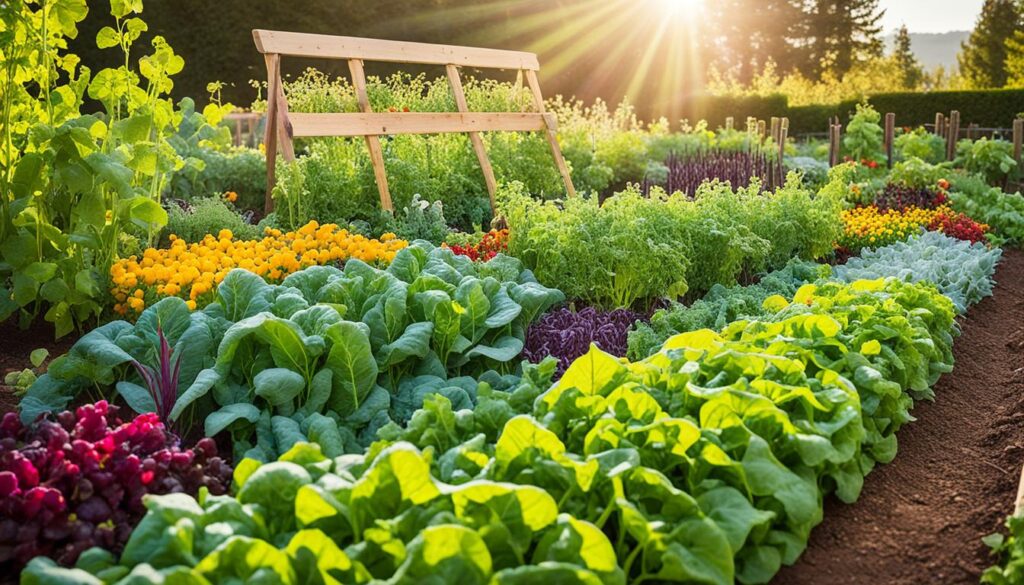
Conclusion
Starting a sustainable garden is a great way to help the planet, grow your own food, and feel closer to nature. By picking the right spot, making healthy soil, drawing in good bugs, and saving water, you can make a garden that grows well year after year. This guide gives you the tips and tricks to start your own sustainable garden at home.
Choosing to garden sustainably is good for the earth and makes you feel proud and connected to nature. From planning your garden to saving seeds for later, every step helps make your garden better for the planet. By gardening sustainably, you get to enjoy lots of fresh produce and help make the world greener.
Whether you’re new to gardening or have been doing it for years, this guide’s tips will help you make a garden that’s good for you and the earth. Enjoy growing your own food, helping bees, and living more sustainably.
FAQ
What is a sustainable garden?
A sustainable garden uses eco-friendly ways to save resources and increase positive outputs like compost and homegrown food. It combines organic methods, saves resources, and mimics nature.
What are the key benefits of sustainable gardening?
Sustainable gardening cuts down your carbon footprint, builds healthy soil, and attracts good insects. It also gives you a steady supply of fresh, nutritious food.
How do I choose the right spot for my sustainable garden?
Pick a spot that gets enough sunlight, drains well, is close to water, and near your kitchen. Most veggies need 6 hours of direct sun. Leafy greens can grow in partial shade.
How do I prepare the soil for a sustainable garden?
Start with healthy, rich soil for a great garden. You can till the soil and add compost, or use raised beds with good soil or compost. Mulch around plants keeps moisture in, stops weeds, and improves soil over time.
What plants should I choose for my sustainable garden?
Pick plants that fit your local climate and soil. Native plants need less care and are tough. Hybrid varieties that fight diseases can cut down on pesticides. Mix veggies, herbs, and flowers to draw in pollinators and beneficial insects.
How can I make my garden more water-efficient?
Use less water in your garden. Collect rainwater, use drip irrigation, and mulch to lower evaporation. Ground covers like wood chips keep soil moist.
How can I attract pollinators and beneficial insects to my garden?
Plant flowers that bloom a lot to feed butterflies, bees, and other pollinators. These insects help control pests naturally, so you use fewer chemicals.
What is companion planting, and how can it benefit my sustainable garden?
Companion planting means growing plants together to help each other. Some plants give nutrients to others, while others keep pests away or attract good insects. Choosing the right plants together makes your garden better and more resilient.
How can I save seeds from my sustainable garden?
Saving seeds from your garden saves money and lets you grow your favorites again. Focus on saving seeds from peas, beans, tomatoes, and peppers. If you dry and store them right, you can replant them next year.
Source Links
- https://www.thegardencontinuum.com/blog/grow-your-own-a-beginners-guide-to-sustainable-vegetable-gardening-at-home – Grow Your Own: A Beginner’s Guide to Sustainable Vegetable Gardening at Home
- https://bonnieplants.com/blogs/garden-fundamentals/organic-gardening-for-beginners – Organic Gardening for Beginners | How to Start a Garden
- https://kellogggarden.com/blog/gardening/how-to-start-a-sustainable-garden/ – How to Start a Sustainable Garden
Top Companion Plant Pairs Every Gardener Should Know
Ever wondered what makes a garden pest-free and thriving? The secret might be in companion planting. But what is it, and how does it boost your gardening success? Learn about the top plant pairs that work together for a harmonious garden.
Key Takeaways
- Companion planting is the strategic pairing of plants that mutually benefit each other
- Certain plant combinations can deter pests, improve soil health, and increase yields
- Knowing the best companion plant pairs can help you create a thriving, low-maintenance garden
- Incorporating flowers and herbs alongside your vegetables can attract pollinators and beneficial insects
- Understanding the science behind companion planting can help you make informed decisions for your garden
What Is Companion Planting?
Companion planting means growing different plants together for mutual benefits. By picking the right plants to grow together, you create a garden that thrives. This method combines ancient farming wisdom with modern science.
Understanding the Benefits of Growing Plants Together
When you practice companion planting, you use the natural strengths of plants. Some plants offer shade or support, while others keep pests away or improve soil. This creates a garden that helps each plant grow better.
- Increased pest resistance through natural pest deterrents
- Enhanced soil fertility from nitrogen-fixing plants or those that attract beneficial insects
- Improved pollination from nectar-rich flowers that attract pollinators
- Greater overall plant health and productivity
Proven Examples of Successful Companion Planting
The Three Sisters method, with corn, beans, and squash, is a classic example. Corn supports the beans, beans enrich the soil, and squash keeps weeds down. This trio shows how plants can work together well.
“Companion planting is nature’s way of minimizing pest damage, boosting soil fertility, reducing weed competition, and, ultimately, increasing yields.”
Evidence-Based Companion Planting Philosophy
Companion planting has grown a lot in recent years. It’s moved from old stories to solid science. Now, thanks to scientific companion planting research, we know which plants work well together.
Before, people thought some veggies had special friends and enemies. But new studies have shown this isn’t always true. They’ve dispelled companion planting myths. Now, we see how plants help each other when grown together.
“The bottom line is that there is simply more evidence for ‘good’ companions than ‘bad’ ones, so the focus is now more on why vegetables need friends.”
Studies show that most plant pairs help each other out. They improve pest control, make nutrients available, and attract pollinators. This proves the benefits of choosing the right evidence-backed plant pairings.
With this evidence-based companion planting philosophy, gardeners can plan their gardens with confidence. They know their plants will grow well together. It’s an exciting time for gardening!
Examples of the Best Companion Plants
Companion planting can greatly benefit your garden. It helps with pest control, plant health, and flavor. Let’s look at some top pairings for your garden.
Basil and Tomatoes: A Classic Combo
Basil and tomatoes are perfect together. Basil keeps away thrips and moths that harm tomatoes. It also brings in bees, which helps pollinate and taste better.
Dill: Attracting Ladybugs to Control Pests
Dill is great for attracting ladybugs. These bugs eat pests like aphids and spider mites. Adding dill near your veggies uses these helpful insects to protect your plants.
Other great beneficial plant pairings include:
- Borage goes well with tomatoes, drawing in bees and making strawberries taste and grow better.
- Garlic and garlic spray keep pests away with their strong smell.
- Mint keeps aphids, ants, and flea beetles away, making it a top choice for pest control.
- Nasturtiums draw caterpillars away from cabbage, broccoli, and kale.
- Parsley brings in beneficial insects to protect and pollinate tomatoes.
Using these successful companion planting examples in your garden creates a healthy, balanced environment. Your plants will thrive and be more productive.
The Science Behind Companion Planting
The study of companion planting is a deep dive into how plants interact with insects and each other. Scientists have found out why some plants work well together. They’ve uncovered the secrets of nature’s clever designs.
Take radishes and pumpkins, for example. When grown together, radishes keep away the squash bug from pumpkins. This happens because radishes release chemicals that pumpkins can absorb. These chemicals protect pumpkins from pests.
Tomatoes and basil are another great pair. Basil’s scent hides the tomatoes from pests. This shows how plants can work together using chemistry.
Leaf shape and arrangement matter too. A mix of leaves can confuse pests, making it hard for them to find their target plant. This helps protect the plant from being eaten.
| Companion Plant Pairing | Scientific Explanation |
|---|---|
| Radishes and Pumpkins | Radishes secrete water-soluble glucosinolates that can be absorbed by pumpkin plants, providing them with natural pest deterrence. |
| Tomatoes and Basil | Basil’s strong aroma helps to disguise the presence of tomato plants, making it harder for pests to locate their desired target. |
| Diverse Leaf Arrangements | A confusing array of leaves can effectively conceal a plant from its would-be predators, as pests may struggle to recognize their host amidst the melee of foliage. |
Studies on companion planting, plant-insect relationships, and plant biochemistry and pest deterrence have given us new insights. They show how plants can help each other grow strong and pest-free. By using these principles, gardeners can create gardens that are full of life and pests.
top companion plant pairs
Companion planting is key to a successful garden. By pairing certain plants, you create a balanced garden. This helps both your veggies and flowers grow well. Let’s look at some top pairings every gardener should know.
Vegetables and Herbs: Tried-and-True Combinations
Basil and tomatoes make a classic pair. Basil improves tomato flavor and keeps pests away. Dill and cucumbers are another great pair. Dill attracts ladybugs that eat aphids, keeping cucumbers healthy.
Flowers and Pollinators: A Mutually Beneficial Relationship
Adding flowers to your garden attracts pollinators and boosts plant health. Flowers like zinnias, cosmos, and marigolds draw bees and butterflies. This flower-pollinator companion plant relationship helps pollinate your veggies and makes your garden lively.
“Companion planting is a time-honored tradition that can transform your garden into a thriving, self-sustaining oasis.”
Common Mistakes in Companion Planting
Companion planting can change the game in the garden, but it has its challenges. Both new and seasoned gardeners need to watch out for common companion planting pitfalls. One big mistake is not thinking about how plants grow. Planting tall crops near short ones can block sunlight and compete for resources.
Another mistake is pairing incompatible plant combinations. Some plants do well together, but others can harm each other. For example, some plants release chemicals that stop nearby plants from growing well.
- Failing to keep plants at the right distance from each other
- Mixing plants with different water and nutrient needs
- Not checking which plants are good “companions”
“The key to successful companion planting is understanding the unique growth habits and requirements of each plant species you wish to grow together.”
By looking into successful plant pairings and considering plant growth habits, gardeners can dodge common mistakes. This way, they can enjoy the benefits of this rewarding gardening method.
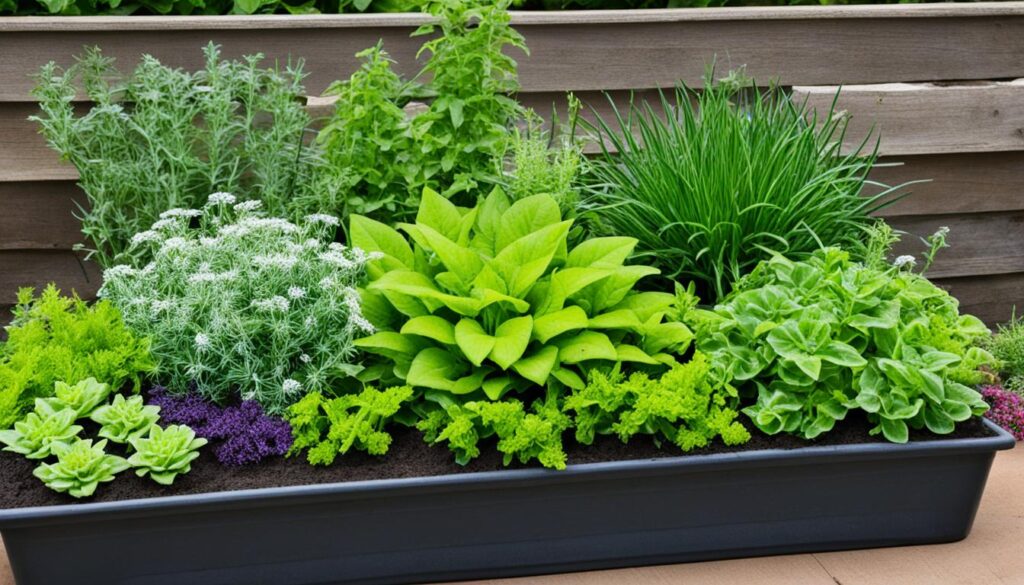
Companion Planting for Pest and Disease Control
Companion planting is a natural way to fight pests and diseases in your garden. Many herbs and flowers have scents or properties that keep pests away. They also draw in beneficial insects that eat pests.
Using Herbs to Repel Pests and Attract Beneficials
Herbs like garlic, mint, and marigolds have strong smells that pests don’t like. Planting these near your veggies can keep pests away. This helps protect your plants.
Some herbs and flowers also bring in good bugs that eat pests. For instance, dill and borage attract ladybugs and other insects that eat aphids and other pests.
| Herb | Pest Repellent | Beneficial Insect Attractor |
|---|---|---|
| Garlic | Aphids, beetles, rodents | – |
| Mint | Aphids, ants, cabbage worms | – |
| Marigolds | Nematodes, aphids, beetles | – |
| Dill | – | Ladybugs, lacewings |
| Borage | – | Bees, lacewings |
By adding these companion plants for pest management to your garden, you make a balanced ecosystem. This approach naturally keeps pests away and brings in beneficial insects. It makes your garden healthier and more sustainable.
“Companion planting is all about creating a diverse, self-sustaining garden ecosystem that works in harmony to control pests and diseases naturally.”
Incorporating Flowers into Your Vegetable Garden
Adding flowers as companion plants to your vegetable garden brings many benefits. They make your garden look great and help keep pests away. Pollinator-attracting flowers like nasturtiums, marigolds, and zinnias draw in good insects that eat garden pests.
When picking flowers for companion planting, think about when they bloom, how much sun and water they need, and how big they get. This way, your flowers and vegetables will work well together. They’ll make your garden a healthy, diverse place.
Flowers for Pest Control and Pollination
- Marigolds keep pests like aphids, nematodes, and rabbits away. They’re a great ornamental for pest control.
- Nasturtiums draw in ladybugs and lacewings. These insects eat aphids and other pests.
- Zinnias are easy to care for and pollinators love them. They help pollinate your vegetables.
By adding different kinds of pollinator-attracting flowers to your garden, you make a great place for your plants and local wildlife.
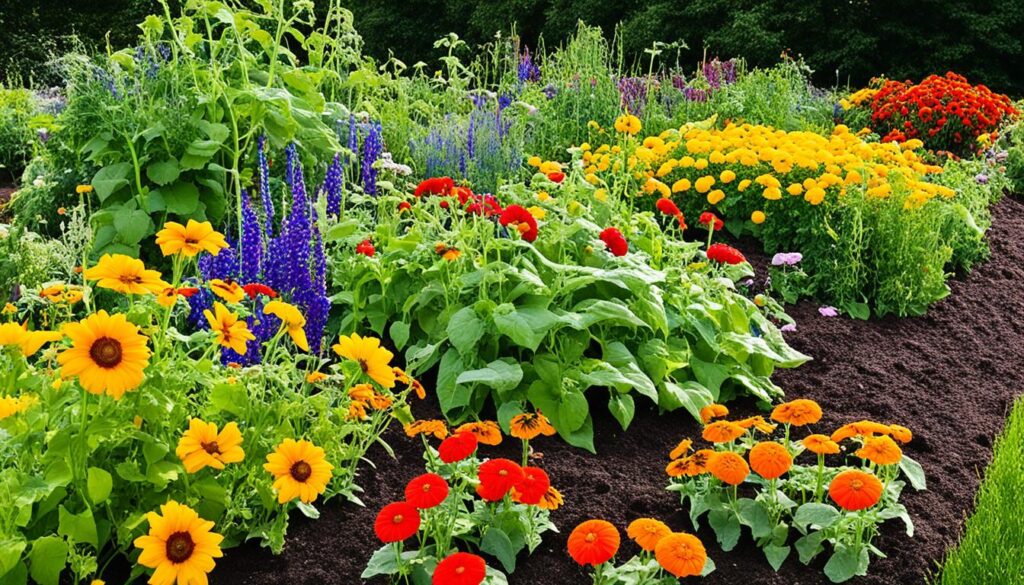
“A well-designed flower border can be both beautiful and functional, providing valuable habitat and resources for beneficial insects while enhancing the overall health and productivity of your vegetable garden.”
Bad Neighbors: Plants to Avoid Planting Together
Companion planting pairs plants to work well together in the garden. But, some plants don’t get along and should be kept apart. Knowing which plants clash is key to a healthy garden.
One big reason to keep some plants apart is they compete for things like nutrients and sunlight. Plants that fight over these resources shouldn’t be planted together. For instance, zucchini and winter squash vines can overshadow lettuce, making it hard for the lettuce to grow.
It’s also smart to keep plants that get the same diseases apart. This stops one sick plant from spreading its illness to others. So, tomatoes and potatoes shouldn’t be side by side since they can both get the same fungal diseases.
| Incompatible Plant Combinations | Reason for Avoiding |
|---|---|
| Zucchini or Winter Squash vs. Lettuce | Competition for resources (nutrients, water, space, sunlight) |
| Tomatoes vs. Potatoes | Susceptibility to the same diseases (e.g., fungal infections) |
| Brassicas (Cabbage, Broccoli, Cauliflower) vs. Tomatoes | Allelopathic effects (release of chemicals that inhibit growth of other plants) |
By knowing which plants don’t mix well, gardeners can grow a garden that’s full of life and productivity. This way, they make the most of planting together while avoiding problems with plant relationships.
Conclusion
Companion planting is a key gardening method that makes your garden better. It pairs plants together to keep pests away, improve soil, and draw in helpful insects. This approach boosts your garden’s productivity and looks.
It doesn’t matter if you’re growing veggies, herbs, or flowers. Using companion planting leads to more food and a healthier garden. You can try pairing basil with tomatoes or find new ones to see what works best.
Every garden is different, so try out various plant combinations. Watch how they interact and change things as needed. With a diverse garden, you get a space that’s easy to care for and supports both you and local wildlife.
FAQ
What is companion planting?
Companion planting means growing plants together that help each other out. This method stops diseases, keeps pests away, and gives shade to other plants. It makes your garden healthier and more productive.
What are the benefits of companion planting?
It cuts down on pesticides, draws in pollinators, enriches the soil, and boosts your harvest. It’s a smart way to build a garden that’s full of life and needs less care.
What are some examples of successful companion plant pairings?
Great pairs include basil with tomatoes, dill with ladybugs, and borage with strawberries. Zinnias, cosmos, and marigolds also attract good bugs to your veggies.
Is there scientific evidence to support companion planting?
Yes, studies show that certain plants grow better together. They can fight pests, grow faster, and help wildlife. We’re learning more about how plants help each other out.
What are some common mistakes to avoid in companion planting?
Don’t pick plants with big roots that might compete, plant them too close, or ignore how they grow. Make sure to check which plants work well together before you start your garden.
How can companion planting help with pest and disease control?
Herbs like garlic, mint, and marigolds keep pests away with their strong smells. Planting them with veggies helps control pests. Some plants, like dill and borage, bring in good bugs that fight pests and boost crops.
What are some good flower choices for companion planting?
Flowers such as nasturtiums, marigolds, and zinnias keep pests away and draw in helpful insects. Pick flowers that match your veggies in sun, water, and growth needs for the best results.
Which plants should not be planted together?
Don’t plant plants that fight over resources like nutrients, water, space, and sunlight. Keep plants that get the same diseases apart to stop disease from spreading.
Source Links
- 10 Must-Have Blooms for Your 2025 Garden
- The Health Advantages of Gardening You Need to Know
- How to Create a Small Vegetable Garden Layout Plan: A Beginner’s Guide
- DIY Garden Projects for Small Spaces: Upcycling Ideas to Maximize Your Garden
- Watering Techniques for Small Gardens: Ensuring Your Plants Thrive
- Small Border Plants for Landscaping: Adding Beauty and Functionality to Your Garden
- Year-Round Small Space Gardening: Seasonal Planting Tips for Maximum Harvest
- Essential Tools for Small-Space Gardening: What You Really Need
- The Ultimate Guide to Container Vegetables: What to Grow in Small Spaces
- Budget-Friendly Gardening: How to Create a Thriving Garden on a Tight Budget
- How to Optimize Sunlight in Small Gardens: Tips for Better Plant Growth
- DIY Vertical Planters: Creative Ideas for Small Space Gardening
- Companion Planting for Small Vegetable Gardens: Boost Growth and Deter Pests
- Container Gardening Essentials: Choosing the Right Pots, Soil, and Plants
- Vertical Gardening Techniques: Maximizing Your Small Space with Climbers and Vines
- How to Build a Raised Bed Garden in a Small Backyard: Step-by-Step Guide
- The Best Vegetables for Small-Space Gardens: High-Yield Varieties You Need to Grow
- Smart Vegetable Garden Layouts for Small Spaces: Maximizing Your Green Thumb in Compact Areas
- 40. Best Practices for Managing a Sustainable Garden Year-Round
- Building a Wildlife Pond for Biodiversity
- Advanced Techniques in Sustainable Gardening
- How to Create a No-Till Garden
- The Mental Health Benefits of Gardening
- Using Technology to Enhance Sustainable Gardening
- Getting Certified Organic: Steps and Benefits
